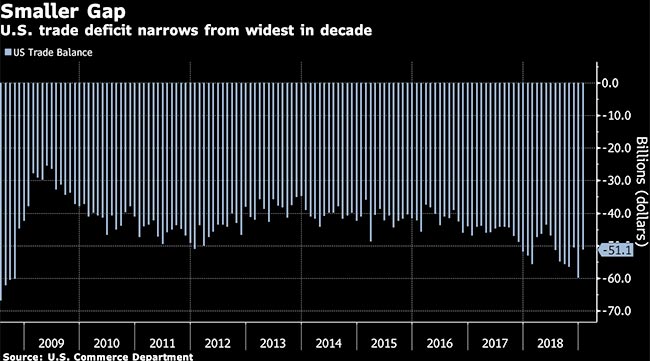January Trade Gap Narrows as Imports From China Plummet

The U.S. trade deficit pulled back in January from the widest level in a decade as imports from China plunged, suggesting American companies had been rushing shipments the prior month to beat an expected tariff boost.
The deficit in goods and services narrowed to $51.1 billion, the Commerce Department said March 27, smaller than the median estimate of economists. Imports fell 2.6% while exports rose 0.9%. The merchandise-trade gap with China — the target of President Donald Trump’s trade war —shrank to $33.2 billion as imports from the nation dropped 12.3%.
Levies on Chinese goods had been set to increase Jan. 1 before Trump put them on hold while trying to work out an accord with China over the trade war, while the Lunar New Year holiday also tends to cause swings in the figures early in the calendar year.
Trump may yet have difficulty achieving his goal of a sustainably lower deficit as slowing global growth and a strong dollar weigh on exports, while American demand continues to support shipments of imported goods.

U.S. and Chinese officials resume talks this week on a deal that could be a step toward economic peace, with signs that both sides want to avoid any escalation of the eight-month trade war. Trump’s top trade negotiator is due to visit Beijing on March 28-29, while China’s lead official plans to travel to Washington the following week.
The January trade data compared with a $59.9 billion deficit in December that was a 10-year high and a median estimate of economists surveyed by Bloomberg News calling for a deficit of $57 billion. The trade deficit widened last year to $621 billion, also a 10-year high, as tax cuts boosted domestic demand for imports and a strong dollar weighed on exports.
March 27 figures showed the deficit in goods narrowed to $73.3 billion, while the surplus in services edged up to $22.1 billion. The report was delayed three weeks from the original date because of the government shutdown earlier this year, and the Commerce Department canceled the release of the preliminary January figures on merchandise trade.
U.S. trade deficit plunges nearly 15% in January to five-month low of $51.1B. Exports up 0.9% - first increase in four months. Imports down 2.6%. Surprise drop in trade gap may be a boost for first-quarter GDP. China tensions causing volatility in trade figures ... — MarketWatch Economy (@MKTWeconomics) March 27, 2019
Overall exports increased to $207.3 billion, with gains in cars, trucks, jewelry and consumer goods. Aircraft shipments decreased. Imports decreased to a seven-month low of $258.5 billion, dragged down by computer accessories, semiconductors and oil.
Soybean exports more than quadrupled to $1.2 billion, which may reflect increased purchases by China after the country pledged to buy more of the crop. At the same time, overall exports to China fell to $7.1 billion, the lowest since 2010 on an unadjusted basis.
There are fresh signs cooling global growth may weigh on exports of American-made goods. This month, the Organization for Economic Cooperation and Development cut its 2019 global growth forecast to 3.3 % from 3.5%, China lowered its growth target, and the European Central Bank slashed its projection for the region.




